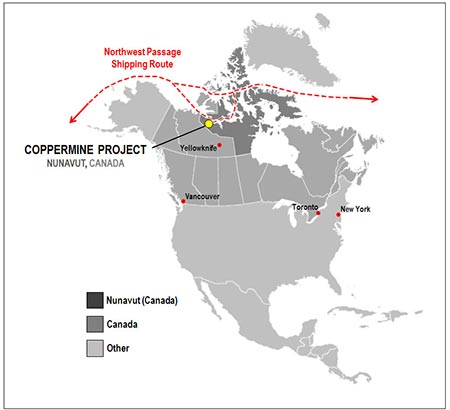VANCOUVER — Kaizen Discovery (TSXV: KZD; US-OTC: CCNCF) is about to kick-start exploration for sediment-hosted copper deposits at its Coppermine project, 5 km south of the community of Kugluktuk, Nunavut.
Heading the exploration team is sed-copper mogul David Broughton, who joined Kaizen in January as vice-president of exploration, but continues to serve as an executive member of Ivanhoe Mines (TSX: IVN; US-OTC: IVPAF).
“We wouldn’t get excited if we knew there was nothing there,” Broughton says during an interview with The Northern Miner. “Our team has hands-on experience with the world-class deposits in the African and Congolese copperbelts, and we all see the potential at Coppermine.”
The greenfield project covers a 115 km strike and 23 km dip-length of a prospective, gently dipping sedimentary contact that trapped migrating copper-rich fluids during the Neoproterozoic.
“There’s something really special about that period of time,” Broughton says, explaining that the earth’s major landmasses, which were positioned along warmer latitudes, broke apart during this period. The disassembly promoted the growth of huge ocean basins capable of producing highly oxidized brines that stripped the metals out of the sediments and deposited them along contacts with reducing strata.
At Coppermine during the early 1990s, Cominco tested 2.5 km of the prospective contact with widely spaced drill holes and found disseminated sulphides, but no assays have been reported.
Meanwhile at surface, there are high-grade copper showings over 30 km, with grabs up to 7.3% copper and 26.7 grams silver per tonne, along with numerous copper-silver occurrences cutting through the older volcanic package. The rest of the target remains underexplored.
“There’s clearly a big system at play here,” Broughton says. “Now it’s a matter of finding out whether or not it has any legs.”
Kaizen is gearing up for a 1,500-metre drill program to test the strike and down-dip extents of the favourable stratigraphy. But most of the work will be spent surveying the property at surface to understand the larger-scale, stratigraphic controls on mineralization.
Broughton calls the program “conservative,” but if there’s one thing his years of working in the African copperbelts has taught him, it’s that a humble approach often leads to success.
“When you work on major discoveries you learn that not every single drill hole is a hit,” he says. “Sometimes it’s like you’re living and dying with every hole, and there isn’t a deposit out there that isn’t like that. This project will likely be the same too, so we want to be smart with how we approach it. That’s our edge.”
Broughton’s legacy of finding giant copper deposits took centre stage at this year’s Prospectors & Developers Association of Canada convention in Toronto, when he and his Ivanhoe exploration team were given the Thayer Lindsley international minefinder award. The award recognizes Broughton’s contribution to the discovery of Kamoa — the world’s largest, undeveloped copper deposit — in the Central African Copperbelt.
Kaizen, which means “continuous improvement” in Japanese, was spun out of Higher Power Exploration — a private, specialized exploration group controlled by mining billionaire Robert Friedland — after it had swallowed a small-asset, Canadian junior explorer called Concordia Resources in 2013.
Since then, Kaizen has steadily injected promising Canadian properties into its portfolio through a series of acquisitions, with the financial backing of strategic partners such as Itochu, a leading Japanese trading house.
Broughton first heard about the Coppermine project while he was working with Ivanhoe in Africa, and took an interest in splitting his time between the two companies.
“The benefit for working under the Ivanhoe umbrella is that you get to share duties, and everyone gives input into the technical side of things from a variety of backgrounds. It makes for a stronger team with a better chance at success.”
Kaizen shares have traded with a 52-week window of 25¢ to 28¢, and closed at 28¢ at press time. The company has 158.3 million shares outstanding for a $42-million market capitalization.


Be the first to comment on "Kaizen searches for Kamoa analogues in Canada’s Far North"